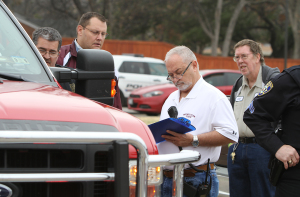
In response to an unsubstantiated bomb threat, a campus-wide evacuation was ordered Dec. 8 at 9:45 a.m., interrupting finals and forcing students to leave campus for shelter off-campus.
Dan Williams, chief of campus police, said University President Jesse Rogers wanted to err on the side of caution in ordering the evacuation.
“We just didn’t have enough to determine if it was a credible threat,” Williams said.
Compared to last year’s shooting threat, which did not result in an evacuation or school cancellation, Williams said he and administrators had much less time to react to the threat.
“The first one came in on a Sunday night so we had nine to 10 hours to begin investigating to determine if we should cancel school or not,” Williams said. “This one came in earlier than classes, but we didn’t see it until 9:30 a.m. That’s why the call to evacuate was made.”
Palmer Buck, Austin Fire Department battalion chief in charge of special operations, said making the decision to evacuate for a bomb threat can be difficult because of the risks that come with a mass evacuation.
“That’s a very tough decision for the educators to make. We’ve done it both ways here. The University of Texas has had a couple of bomb threats, and one time they set off the sirens and did an entire campus-wide evacuation, and what we saw was what we expected to see, which was several wrecks and a lot of people panicking and walking through different areas without complete containment,” Buck said. “We did a lot more harm than good if we had sat in place or done some sort of methodical evacuation. But in the same point, you’re going to be roasted alive if you get a bomb threat, you don’t act on it and something does go off. So you really are between a rock and a hard place.”
Typically in emergency situations, Williams said it comes down to either evacuating or sheltering in place.
“Shelter in place is designed for an immediate threat where you don’t want people wandering around campus,” Williams said. “Typically in a bomb threat situation, if you think it’s credible or if you can’t determine if it is, your only option is to err on the side of caution and evacuate.”
And Buck said he agrees that evacuation tends to be the rule for bomb threats, but with some caveats.
“With a bomb threat we have to assess the threat, and if you have a good idea where the bomb is supposed to be, then you might feel comfortable in keeping people in place. If the only way to evacuate people is through where that blast radius might be then it’s going to be safer to keep them in place,” Buck said.
While ordering an evacuation may sometimes be the best option, Buck said precautions should be taken to ensure the evacuation does not create more harm than good.
“What’s worked best for us is to just pull the fire alarm because people know what the fire alarm is. Fire alarm goes off and you get out of the building,” Buck said. “If you get on the loudspeaker and say, ‘There’s been a bomb threat, you need to evacuate the building,’ you put in panic that you might not necessarily need to have done.”

Investigation
Williams said an investigation into the threat is ongoing, but it could go on for months—if not longer.
“It’s not progressing as quick as we’d like. We’ve continued to investigate in conjunction with the FBI and we’ve turned everything over to them,” Williams said. “It’s hard to say when the investigation will be concluded. We can sit on it for months until we get new information.”
Williams said the best chance of solving the case would come if someone came forward with information on the crime.
“It’s probably not a solvable crime unless somebody comes forward with information because that will allow us to get a search warrant,” Williams said.
Williams said he hopes to feature the case on Crimestopper’s “Crime of the Week” to attract tips that may lead to solving the case.
“I’ve also learned that when you put money on the table for a tip, you’re a lot more likely to get the information you need,” Williams said.
Luckily, according to Williams, it is often the perpetrator’s need to brag that gets them caught.
“Most of the time these individuals can’t keep their mouths shut,” Williams said. “So I hope if someone hears about it they come forward.”
RELATED STORY: Campus Open After Bomb Threat














